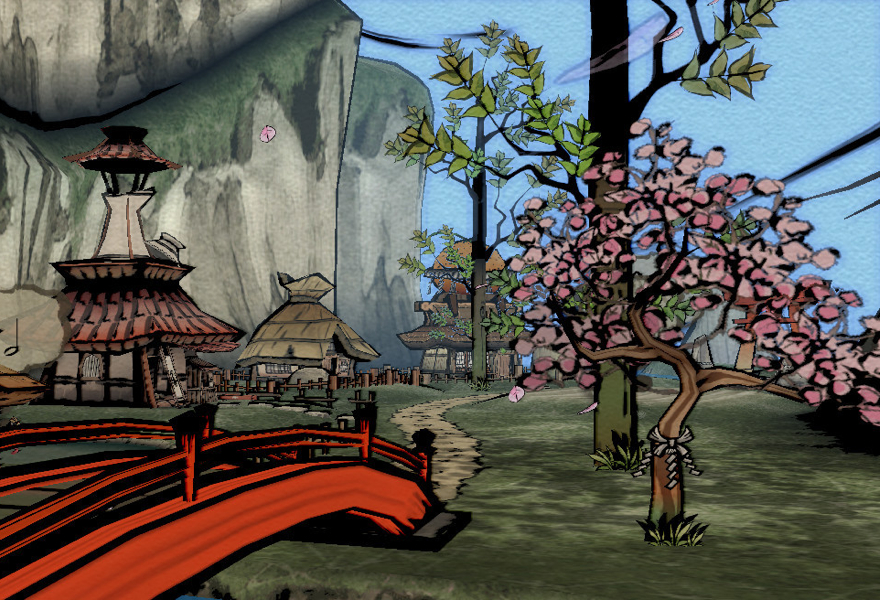The first time I saw The Legend of Zelda: Ocarina of Time, I was nine. I was in my best friend’s bedroom with his sister, the two of them in a heated argument over who had figured out how to get out of the very first room, such was the novelty of 3D games at the time. The game’s world, conjured by its developer Shigeru Miyamoto, was weird. Your character’s mentor is a gigantic tree, your enemies not arbitrary “baddies”—ghouls, demons and the like—but sprung from the world around you. Vicious shrubs pounce from the ground to pester you, spirits of the mountain, taking the form of iron-clad lizards, whip you with their tails. And the names, too, could tangle tongues unfamiliar with them: Deku, Dodongo, Gerudo.
Shigeru Miyamoto attributes much of his game’s atmosphere and mythology as being inspired from growing up near, Kyoto, Japan’s old capital. There he explored the caves, collected insects, and soaked in the quietude of nature. The way he chose to express these memories in Ocarina of Time, however, was more than mere nostalgia; it was in the guise of Japan’s homegrown religion Shintoism.
Very few people in the west are familiar with Shintoism, but we’re all familiar with its artifacts. You may not know them by name, but “Kami,” for example, are the ghostly Japanese monsters attributed to worldly phenomenon—like fire, water, wind, or love— which make up the cast of characters in many Japanese anime. They aren’t good or evil like Western deities: more like “dirty” or “clean,” and these states of cleanliness modulate over the course of time. So perhaps the kami of a river became evil when polluted in, or the fire kami burns or warms you.

These artifacts define Miyamoto’s work. The mythologies of the Legend of Zelda—that three goddesses created the world as well as a sacred, holy realm—is almost directly taken from Shintoist mythologies of the origin of Japan. Aspects of the game’s story—particularly the fouling of pure areas, such as lakes or trees, which the hero must then purify—are actually Shintoist ethics at work. The cyclical birth and rebirth of our hero is a more Buddhist concept, but still: Buddhism was introduced into Japan between the 3rd and 6th century, and much of it was integrated into the then-nascent Shinto.
More than that, the atmosphere of Miyamoto’s world is Shintoist-inspired. No one’s quite human, everyone is bound elementally to something. They are children of the forest, of water, mountain, etc., and their behaviour is likewise linked to their homeland; stubborn like rocks, for instance, or beautiful and gentle like water. The “Legend” of the Legend of Zelda is set up to look like a medieval folklore, but in truth it is a Japanese folktale composed of Shintoist elements, which has been respun by Miyamoto.
This isn’t the only game to adapt or use outright Shintoist elements. The PS2 game ?kami is basically a lesson in it. Its story, myths and characters are taken from Japanese mythology. The Japanese sun god Amaterasu is undisguisedly in the game as the sun—and even the game’s name, ?kami, means “great god” in Japanese. Both of these games—and many like them, though with less tenable Shintoist origins, like the Silent HIll and Harvest Moon franchises—are tied to the teachings of Shintoism.
It isn’t a coincidence that Miyamoto felt inspired by his childhood outside Kyoto and drew Shintoist elements into to create Legend of Zelda. Because, as Shintoism has grown to advocate an increasingly environmentalist message, that countryside has disappeared. It may be Miyamoto’s own longing for that lost childhood—and also, innocence—which had him create a game in which a young boy runs about the land restoring violated things, like trees, minds and bodies, back to their purer state. Link does this in most, if not all, subsequent games.
The message is given to us is that people would be happier, less avaricious and more loving if only they allowed the world to revert to nature. That this message was empathized with by audiences all over the world is not surprising. It’s a feeling which has passed through anyone who has sat in a forest, and listened to birdsong, or in the wind in the trees, and returned to the more-often-than-not dirty, noisy, hostile city.
And this was part of the appeal. When we’re not looking forward toward utopian nations and time travel, we’re looking backwards to a time when forests covered the land, not cities, and life loosely defined as “simpler.” Today, there are initiatives to reclaim abandoned urban areas as green spaces—we have “greening” as a verb, now—and people are increasingly seeking to move out of cities, and not into them. Once urban environments were a novelty and a luxury, now they are much more divisive.

How loyal these representations in videogames are, however, up for debate. The past 100 years has seen Shintoism change dramatically, from being a set of culturally unifying principles to its more animistic form today. Part of the reason for this has been the waning political importance of the Emperor—who was traditionally the child of the sun god—and the modernization of Japan. A researcher in Japanese religion at the School of Oriental Studies in London, Lucia Dolce says modern Shintoist intuitions have “[rewritten] the meaning of Shinto in order to appeal to a modern audience.” And that this was done to appeal to people, like Miyamoto, who had become disenfranchised with a modern, urban Japan.
It’s this aspect of Shintoism which has captured the Western imagination and brought games like Ocarina of Time so much of their success. It is a story which these last hundred years has made especially poignant: restoring the countryside and improving our proximity to nature. The success of these videogames and media like them has been that they tapped into something which not just the developers wanted, but which we all want: a renewed closeness with nature, after watching it get swallowed up by cities.
